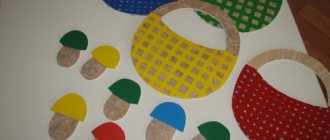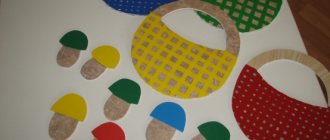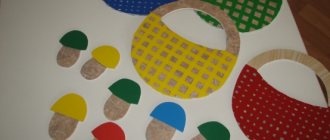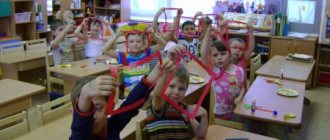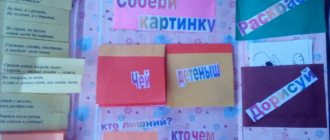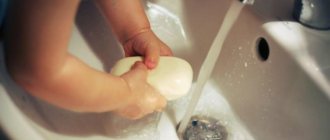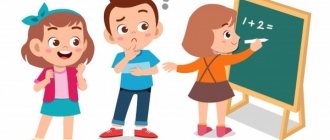Teaching numeracy, systematized and methodologically justified by the Federal State Educational Standard (FSES), is included in the system of work with preschoolers in kindergarten. However, the age characteristics of children require particularly careful preparation of visual aids. The most important role is given to the counting material. We will look at the types of counting material used in mathematics classes in different age groups, and give advice on how to make it yourself as a demonstration and handout.
- 2 Features of demonstration and handout material for different age groups
2.1 Types of handouts2.1.1 Photo gallery: examples of counting handouts
- 3.1 How to make didactic materials for the preparatory group with your own hands
3.1.1 Photo gallery: example of a homemade laptop
- 4.1 Photo gallery: examples of individual cards and a picture for a mobile folder
- 5.1 Photo gallery: individual cards for the senior group
The validity of using visual counting material in kindergarten
In a preschool educational institution, children begin to master counting at the age of three, and this is their main mathematical activity. Learning takes place with the indispensable support of visual aids, since abstract logical operations performed during counting (merging and dividing sets, comparing quantities and numbers, comparing sets) are difficult for children to understand and require “objectification.” Visual counting material is a comprehensive didactic tool aimed at developing basic ideas about counting as part of targeted learning.
Famous teacher K.D. Ushinsky said: “Children’s nature itself requires visual learning.”
Such benefits are very diverse, and their application in each case depends on:
- specific content of educational material (for example, teach children of the second youngest group to distinguish between the concepts of many and few);
- methods used (more precisely, certain gaming techniques, for example, illustrations for a fairy tale in which characters learn to count);
- the age of the children (if in the second younger group there may be cards with pictures of the same animal, then in the older group the pictures depict different animals, that is, the essence of the phenomenon being described becomes more complex).
Counting in kindergarten is mastered along with other didactic skills and concepts, for example, learning about colors: distribute the mushrooms into baskets of the corresponding colors and say which one has more/fewer of them
Visual material must meet the following requirements:
- scientific (correspond to scientific data on counting);
- pedagogical (carry an educational, developmental, educational load);
- sanitary and hygienic (do not contain harmful substances, do not cause eye strain;
- aesthetic (beautiful design, bright and clear images)
Interactive educational poster “Fun Math”
Ekaterina Kladova
Interactive educational poster “Fun Math”
Goal: to consolidate children’s knowledge of the material covered on FEMP
Tasks:
Educational:
1. Repeat counting within 5, use in speech.
2. To develop children’s ability to distinguish objects by size and designate them with the words high - low, long - short, wide - narrow.
3. To develop children’s ability to distinguish and correctly name geometric shapes and select according to a given characteristic.
Educational:
1. Develop attention, memory, thinking, active vocabulary.
2. Develop finger motor skills.
Educational:
1. Develop an interest in joint activities with adults and peers.
2. To develop the ability to listen and hear the teacher, to act according to the verbal instructions of an adult.
Age: for children of primary preschool age.
The material will be useful:
Teachers of preschool educational institutions
Parents of preschool children.
Long weekends provide an opportunity for children and parents to spend a lot of time together. I would like to bring to your attention an interactive manual for preschool children (middle group)
according to FEMP.
teaching methods are difficult to imagine without multimedia interactive technologies that allow the use of text, graphics, audio, and video. These opportunities significantly expand the scope of application of computer technology in the educational process. Visual and sound accompaniment help to activate the imaginative thinking of children of primary preschool age, which contributes to a more holistic perception of the material and improves the quality of education in the pedagogical process.
The interactive poster is primarily designed to provide a high level of visibility of the educational process. K. D. Ushinsky, revealing the advantages of visual learning , noted that the child “. thinks in forms, colors, sounds"
.
Interactive poster “ Fun math for kids ”
designed for children of primary preschool age (junior group, educational area - cognitive development
(FEMP)
in the Power Point environment and made using the
“single screen”
, which allows you to visually perceive
the poster as one slide, without noticing the transitions between them. This methodological development can be used to review the material or a final lesson on the formation of elementary mathematical concepts ... The poster consists of several slides. The number of slides varies depending on the number of objects presented on the poster plus the title slide and slides with test tasks. The transition between slides is done by clicking on the image of one from objects through hyperlinks. It is possible to end the slide show at any time by clicking on the button at the top. In the poster “
Fun mathematics for kids " , by clicking on the topic we need (geometric shapes, magnitude, counting), we will see tasks for children who they can do it on their own: find an extra object, use the concepts of
“more-less”
,
“longer-shorter”
,
“wider-narrower”
,
“many-one”
.
By following the hyperlink “geometric shapes”
, we will see pictures where we need to find objects similar to geometric shapes.
If children choose the correct answer, the picture becomes transparent, and if the picture is redundant, it disappears. Having followed the hyperlink “magnitude”
and
“counting”
, children use the concepts already familiar to them:
“more-less”
,
“longer-shorter”
,
“wider-narrower”
,
“many-one”
.
They only need to choose one picture. If the last task is answered correctly, the user goes to a slide with topics, after which he can complete the work, or continue interacting with the poster .
Our students enjoy working with interactive aids . Interaction with them arouses keen interest and promotes the development of cognitive activity.
Features of demonstration and handout material for different age groups
Calculating material in mathematics, like other visual aids, can be of two types:
- large, that is, demonstration, which is used by the teacher to explain and show how to operate with it (magnetic boards, posters, paintings, etc.);
- small, that is, handout (cards, laptops, etc.), using which all children perform certain tasks at the same time, which allows organizing independent activities of children to develop the necessary mathematical skills and abilities.
Visual mathematical material differs in the type of counting activity, which is a priority for a specific age category.
- Second junior group. To form the concept of singularity and multiplicity, you can use, for example, puzzle pictures, cubes in which numbers are surrounded by elements with the same number of fruits (vegetables, animals, etc.) or pictures with dots that need to be correlated with the number. By the way, the same material with dots is still used, only there are more numbers.
- Middle group. Children must be able to give an accurate assessment of a set of objects, in this case counting to 5. For this, pictures depicting objects and numbers corresponding to their quantity are actively used, as well as a combination of a toy and a three-dimensional number. For example, to recognize the graphic image of a number, the task could be as follows: help the bunny find the number 3. Place a moth on a flower with five petals.
- Senior group. Kids count to 10 and can add or subtract one at a time. For clarity, they use, for example, the game of dominoes, matching a number with a picture with the same number of objects.
- Preparatory group. Children can compare numbers “more and less”, and make up given numbers from two smaller ones - 5 from 2 and 3, for example. The demonstration material becomes more complex. These could be tasks for comparing the number of objects in pictures, composing a whole image after sequentially folding numbered cut parts, etc.
Counting sticks are a universal visual aid: they allow you to demonstrate and practice all types of counting activities.
Thus, the first manuals are aimed at ensuring that children learn to correlate the visual image of a number and the number of objects it denotes. In the middle group, this work is no longer on “recognizing” the image of a number, but on quantitative counting up to 5. In the older group, children learn to perform basic addition and subtraction operations, and in the preparatory task materials are comparative in nature, since children already know how to correlate quantities , indicated by numbers.
At any stage of training, it is necessary to think over a way to get acquainted with the graphic image of a number, for example, in the form of creating an application
Types of handouts
As already mentioned, manuals can be demonstration or handout. And there are also those that can be used in both cases (for example, Dienesh blocks). The teacher chooses the types of handouts depending on the age of the children. So, already in the first junior group, children get acquainted with cubes and counting sticks. True, so far the assessment level is “a lot or a little.” Typically, the gradation of the use of types of handouts depends on the age of the children: the younger, the more toys, and the older, the more drawings and diagrams. In general, the following counting aids are actively used in kindergarten:
- Cuisenaire sticks (multi-colored parallelepipeds of different sizes made of wood or plastic are used mainly in the second junior and middle groups, when the concept of quantity is introduced);
- Dienesh blocks (a set of geometric shapes of different sizes, which can be used by analogy with Cuisenaire sticks, as well as to introduce rectangles, triangles, circles, squares);
- cubes (in the younger group they practice the concepts of “many and few”);
- pyramids (as a budget, more affordable version of Cuisenaire sticks and Dienesh blocks);
- beads, buttons (in junior and middle groups);
- pictures, puzzle pictures, cards (for all ages);
- fan with numbers (for senior and preparatory groups, in which the children already clearly associate a number with its graphic image);
- lapbooks, tasks in which can combine all of the above manuals, etc.
Please note that there is no clear age division in the use of counting materials, since their use must be justified from the point of view of the educational goal. And yet, in the senior and preparatory groups, the emphasis is on cards, so that children get used to working with clarity “like at school.”
Photo gallery: examples of counting handouts
The capabilities of counting cubes allow them to be used up to the preparatory group
To master the skill of counting to 5, it is convenient to use special pyramids
A fan with numbers is a tool for school, but can also be used in kindergarten
Using blocks you can practice mastering basic geometric shapes and counting objects in groups
You can learn to count on sticks completely unnoticed: for example, by laying out figures from them
Didactic material on FEMP for the middle group
Oksana Rudneva
Didactic material on FEMP for the middle group
This material is intended for use both in the classroom and for individual work with middle-aged . The attractiveness of the demonstration material is of great importance - with beautiful aids it is more interesting for children to study.
as visual demonstration and handout material during the GCD process for FEMP .
This material can also be used in independent and leisure activities.
Sample games:
1. Game “Which picture is missing”
. I display different subject pictures on a magnetic board. I invite the children to watch and remember, then close their eyes. At this time I remove one picture. Children name the missing picture.
2. Game “Who swapped places”
. I attach pictures to the magnetic board in the corners and in the center. Then I invite the children to close their eyes and swap the pictures.” Children guess.
Second version of the game “Who swapped places”
. I put different pictures in one row. I invite the children to close their eyes. I swap the pictures. Children guess.
3. Game "Vegetable garden"
.
Children “plant”
a certain amount of vegetables in the beds and then compare the harvest.
4. Game “Place the figures on the plane”
.
Butterfly - in the upper left corner. The flower is in the lower right corner.
Strawberries - in the lower left corner. Bee - in the upper right corner.
5. The punch card board game is designed for individual use.
For example, a punch card “Recognize the figure in the picture”
Goal: development of ideas about form. Instructions: “Look at the pictures. Guess what shapes they look like, connect them with paths.
6. Punch card “Geometric Shapes”
. The punch card is a sheet of A4 paper, along the edges of which there are pictures of objects made up of geometric shapes and geometric shapes.
A blank sheet of paper is placed under the punched card. To prevent the sheet from moving, it is secured with a paper clip.
Task: To strengthen children’s ability to distinguish geometric shapes (circle, square, triangle, oval, rectangle)
.
Task: Connect the object with the figures from which it is composed.
7. Educational game “Counting from 1 to 10”
. The goal of the game is to match each number with the corresponding number of balls or strawberries.
8. Game “Counting from 1 to 5”
.
(Cars)
The goal of the game is to place cards with the corresponding number of cars near the main field - the parking lot.
9. Puzzles Counting from 1 to 10. Interesting mathematical puzzles for children learning to count within 10. In order to get a picture, you need to collect stripes with numbers in order.
10. Cards “Count and find the extra picture”
. You need to find one extra picture out of the four offered. The child needs to count how many objects are depicted in each picture, find the extra picture and guess which number dominates on this card.
Count the objects and name which drawing is the odd one out.
11. Didactic game “Toy Store”
.Goal: to consolidate the ability to count objects, find the right number, develop the child’s speech, and the ability to coordinate numerals with nouns.
Progress of the game: The teacher hands out one card to the children: “This is a toy store. There are different toys in different quantities on the shelves. You have in your hands tokens with which you can buy these toys, correctly naming their number." For example: “In the toy store, I want to buy one house (puts a token with the number 1 on the circle, five flowers (puts a token with the number 5 on the circle, nine bunnies (puts a token with the number 9 on the circle, four dolls (puts a token with the number 4 on the circle)
. I bought everything in this department. Let's move on to the next one." develops the child’s speech, the ability to coordinate numerals with nouns.
I hope you enjoyed my tutorials. I wish you all good luck and creative success! Thank you for your attention!
Lapbook for FEMP “Quantity and counting”
A laptop is a folder that contains material on a specific topic. The organization of the material in such a manual is that the teacher arranges the visualization in the form of mini-books, accordion layouts, gift boxes, windows or pockets, etc. In addition, the lapbook necessarily includes tasks of a creative nature.
Lapbooks are also used to form elementary mathematical concepts (EMPs) - the fruits of the teacher’s creative approach to the implementation of learning tasks. Benefits are calculated for a specific stage of training. Since lapbooks were originally made by parents to teach their child, these manuals, put on a “methodological stream,” are now used for individual work, as well as for working in pairs or threes.
How to make didactic materials for a preparatory group with your own hands
First, you need to determine the goals of the Quantity and Counting lapbook.
- Strengthen the ability to count to 10.
- Practice ordinal and quantitative counting.
- Practice the skill of comparing numbers with the number of objects.
- Learn to write numbers.
- Develop the ability to add, subtract and compare numbers within 10.
- Develop active vocabulary, logic, memory and thinking.
- Work on the ability to independently solve assigned problems.
- Cultivate responsiveness, self-confidence and self-confidence.
After the organizational stage, you can proceed directly to production. This process begins with the preparation of the necessary materials. Moreover, methodological questions are developed first, and only then a suitable design is selected for them.
Typically a lapbook includes:
- pictures with numbers for visual perception of their graphic image;
- cards with numbers and objects (either separately or 2 in 1);
- puzzles (cut numbers or pictures, each piece of which shows a number, etc.);
- pictures of fairy tales with numbers in their titles;
- coloring books;
- copybook;
- riddles, counting rhymes, etc.
It is most convenient to organize materials into files, which, in turn, are stored in a folder. The cover of this manual frame should also be brightly designed. But with such packaging, it is troublesome to work with the materials: before use, part of the manual will have to be laid out. So you can take advantage of the experience of your colleagues and make the pages of the lapbook cardboard, and on these sheets you can attach files, pop-up books, and boxes with surprises.
Photo gallery: example of a homemade laptop
For a lapbook, using a binder is the most durable
Cards with dots and numbers can be placed in bright envelopes so that the baby becomes interested in their contents
When producing such a manual, it is assumed that children know how to write
By laying out numbers from elements, children remember the graphic image of numbers and also train their eye
With the help of a lapbook, children quickly and easily understand the essence of comparison
Having solved the example on the garage and on the car, the child must correlate the same answers
Children, as a rule, get excited about playing dominoes.
Do-it-yourself didactic manual for teaching numeracy in kindergarten
Do-it-yourself didactic mathematical manual for preschoolers
Master class on the production of the didactic manual “Fun Counting” for individual work with preschoolers
Author : Natalya Evgenievna Khokhlova Position: teacher-defectologist Place of work: MKDOU No. 22, Miass, Chelyabinsk region Description: master class on the production of the didactic manual “Fun Counting” for individual work with preschoolers on the formation of elementary mathematical concepts. Purpose of the material: for preschool teachers and caring parents. Goal: Production of a didactic manual “Funny Counting” for individual work with preschoolers. Objectives: - learn to create teaching aids with your own hands; - develop creativity. One of the main areas of preschool education is mathematics. “A child’s element is play,” so the main principle is to teach while playing. Teaching mathematics in a playful way develops and shapes the child’s cognitive interest. To make the teaching aid “Merry Counting” we will need materials: White cardboard; Scissors; Glue; Adhesive tape.
And so do the pictures. I made a blank from pictures taken from the Internet and printed them on a color printer. I fit 4 rows of pictures on one A4 sheet. Dimensions of one row: height 4.5 cm, width (length) 28 cm. Each row contains 10 pictures. I will be happy to share my preparations with you. We cut the printed blanks into strips along the lines.
We make the same blanks (strips) from cardboard measuring 4.5 cm * 28 cm). And in addition to each workpiece, we will need two small strips measuring 0.7 cm * 28 cm.
Next, use glue to glue our row of pictures onto the cardboard blank.
If you have a sufficient number of pictures, from magazines, unnecessary books, then you can cut them out and paste them on cardboard, then you don’t need to print the pictures. Next we need a self-adhesive film, which can be of any color. Cut a strip of self-adhesive a little wider than our narrowest strip.
We glue a narrow cardboard strip along the very edge of the self-adhesive, leaving the adhesive part of the film open.
Then we take our wide strip with the picture pasted on it and place it face down, aligning the edges of the narrow and wide strips, also leaving the adhesive edge of the film open.
After the edges of the strips are aligned, we bend the adhesive edge of the film, thereby gluing the narrow and wide strips, turn it over and see what we got.
We process the second edge of the wide strip in the same way. Next, we cover with self-adhesive film the edge of the wide strip where the counting of objects will begin.
Cut a small strip of cardboard or any paper. Size height 4.5 cm, width 0.7 cm.
We put this strip under our sides
And glue a strip of self-adhesive film of the same size on top.
This needs to be done in such a way that we can insert a “slide” strip on this side of the card. Now our card does not look very aesthetically pleasing due to the fact that the narrow strips along the edge of the card do not fit tightly to the base and are puffy. All this can be corrected after all the cards are ready by placing them under a press.
Next, cut out the “engine” strip from the cardboard. It should be a couple of millimeters smaller in height than the manufactured card, and a couple of centimeters longer in length.
We insert the “engine” strip into the manufactured card and the card is completely ready.
I use the didactic manual “Fun Counting”, made with my own hands, in individual work with children on the formation of elementary mathematical concepts, such as quantity and counting. This manual helps solve the following problems: - consolidate quantitative and ordinal counting; - exercise children in counting objects; — secure direct and reverse counting; When working in a compensatory kindergarten, great attention has to be paid not only to the development of mental processes, but also to the development of speech. That’s why I try to select multifunctional aids. Also, working with this manual helps children learn to coordinate numerals with nouns in gender, number, case, and enrich their speech with nouns and adjectives. For example: one pan, two pans, three pans, four pans, five pans;
Or the use of the words one-one-one, two-two; One apple – two apples, etc.; You can count using an adjective - one green apple, etc.
Cards can be made using pictures corresponding to the lexical topic of the week.
If desired, you can make the required number of cards to work with the subgroup. I hope that this teaching aid will be a good help to you and your children. I wish you creative success!
We recommend watching:
Do-it-yourself multifunctional game aid for preschoolers Do-it-yourself didactic aid for younger preschoolers Do-it-yourself didactic aid for kindergarten Do-it-yourself didactic aid “Paired Pictures” for kindergarten
Similar articles:
Game layout for children 4-7 years old “My City”
Multifunctional teaching aid for children 5-6-7 years old
Do-it-yourself manual for developing fine motor skills
Individual cards in mathematics for the second junior, middle, senior groups
Learning to count is something that requires maximum concentration and constant practice from a child. The latter is designed to provide individual cards - methodological aids for working on a topic one at a time or in mini-groups (2-3 people).
- In the second younger group, to practice the concept of one-many, for example, a card may have a picture of a steam locomotive. The child receives a stack of trailers and distributes them according to the card. At the same time, the adult focuses the child’s attention on the fact that at first there were no carriages, then one appeared, and then “many.”
- In the middle group, counting to 5 is very effectively trained by correlating elements of pictures (for example, dots on the back of a ladybug) and a graphic image of the number.
- In the older group, to practice counting to 10, you can use tables with dots and small cards with numbers that children must correlate with each other. Or cards with numbers to restore counting order. By the way, the skill of writing numbers is trained in the same way.
- In the preparatory group, the cards can be graphic examples of addition and subtraction: the child counts the number of objects to the left of the + or - sign and writes the result in the cell provided for this.
For practical reasons, it is better to laminate cards. Then, even if the child needs to write something on an assignment (for example, the answer to the solution to an example), he will be able to do it with a marker that can be easily wiped off the cellophane.
To ensure that the numbers are always in the children’s field of view, you can install a “Fun Counting” folder in the group. She will introduce the kids to both numbers and the number of objects in a group.
Photo gallery: examples of individual cards and a picture for a mobile folder
In the younger group, kids learn to evaluate sets by attaching different numbers of cars to locomotives
In the preparatory group, children perform addition and subtraction in the range from 1 to 10
A child in the middle group must count the spots on the back of a ladybug and connect it with the appropriate number.
In the older group, children learn to perform simple arithmetic operations ranging from 1 to 10
Bright and beautiful pictures from the mobile folder will attract the attention of the children and teach them to correlate the number with the number of objects
Pictures for teaching counting in senior and preparatory groups
There are no particular differences in the form of the pictures, only the tasks, that is, the content, differ.
Photo gallery: individual cards for the senior group
Number cards can be made at home
By rearranging the number of balls, the child will learn to count to 10, as well as sort things according to the “new/old” principle.
An individual card may contain a creative task: sculpt a number from plasticine
Such houses help children learn the composition of numbers
It is worth noting that the cards do not always represent a drawn/pasted image. An individual card may consist of individual elements that are laid out on a sheet. A kind of overlay applique.
Photo gallery: counting aids for the preparatory group
This is how children are presented with the principle of variability of terms with the same amount
This is a dynamic card, that is, it comes with a pocket with balls with examples, as well as cards with answer numbers
In the preparatory group, children easily cope with the task of writing down the neighbors of the numbers in the windows of the house
This guide not only trains math skills, but also develops fine motor skills.
Demonstration counting material is a manifestation of the teacher’s imagination, aimed at ensuring that children learn the basics of mathematical operations while playing. Lapbooks have proven themselves very well, as the children enjoy playing with such large applications, which include pictures, puzzles, and coloring books. When preparing this manual, two important points must be taken into account: the laptop must be strong, that is, not crumble during use, and entertaining, so that with its help the teacher can realize the set training, developmental and educational goals.
